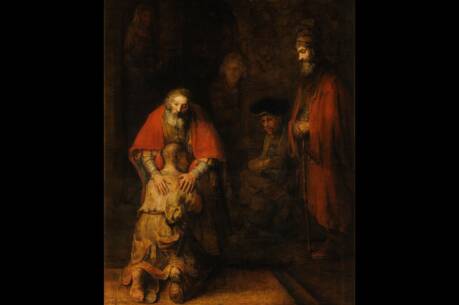Directions to the Nearest Church
The period from Easter to Pentecost celebrates the presence of the risen Christ in the church. The gift of the Spirit to the fearful disciples and the appearance to “doubting Thomas” complete the Easter octave, when early Christians doffed the white robes of baptism and entered a period of exploration of the deeper mysteries of the faith. Until Pentecost, the first reading is always from the Acts of the Apostles, which might be better called the “Acts of the Holy Spirit,” since every important event in the early church is stimulated by the Spirit. The second reading is always from 1 Peter. For prayer and reflection during this period one could do no better than read and meditate on Acts and 1 Peter, which is an eloquent exhortation for Christians to realize their dignity as “a chosen race, a royal priesthood, a holy nation, God’s own people” (1 Pt. 2:9).
Although you have not seen him, you love him (1 Pt. 2:8)
• Both 1 Peter and Acts stress Christian joy; reflect on that true joy that fills your life.
• Pray in gratitude for the newly baptized or those now in full communion, who offer images of hope today.
• Pray over ways that your local parish or community may be a gathering of friends.
The reading from Acts (along with its parallel in 4:32-37) provides “marks” of the early church that should define the church throughout the ages. It is a community called forth by the Spirit (the etymological meaning of the Greek ekklesia), which is characterized by koinonia, “communion” (less accurately, “common life,” N.A.B.), devotion to the Apostolic teaching (didache), the breaking of the bread and prayer. This picture is often dismissed as a utopian view of Christian origins or as an example of early Christian “communism,” which necessarily collapsed under the weight of historical accretion. The emphasis on communion and “holding all things in common” is a way of expressing the Hellenistic idea of friendship. A friend was a person with whom one held all things in common, and friendship was considered to be the highest form of love. The stress on selling property and meeting the needs of others countered the major barriers to true friendship in antiquity—namely, disparity of class and wealth.
Since the Second Vatican Council, there has been unparalleled reflection on the nature of the church. Increasingly the magisterium and theologians of different stripes have stressed a model of communio. Though all share a foundational vision of communion with Christ through the Holy Spirit, its implications are open to different interpretations. Curial theologians seem to understand it primarily as “vertical”—that is, communion under the explicit direction of Rome, so that local and regional institutions are reduced primarily to implementing Vatican directives.
Today’s readings present a horizontal communion, a communion of friends gathered in fidelity to the Apostolic teaching and in breaking of bread and care for those in need. Though obviously a bit simplistic for complex modern society, the New Testament models indicate that communion is to form the institution, and not be subordinated to it. Though during recent tragic days a cardinal in the United States has stressed that a bishop is not a corporate executive, the public face of the church and its centralized authority often mirror a bureaucracy. Church spokespeople often communicate in an ecclesiastical patois similar to “Enronese.”
While this may be true of the “vertical” or church “from above,” the church “along side of” throughout the land provides great images of hope. Thousands of people conclude their journey through the adult initiation rites, united as a community of friends. Parishes continually seek creative ways to bridge the gap between the prosperous and the needy. The Scripture and the “teaching of the Apostles” are presented often through well-thought-out homilies and by thousands of religious and lay educators. In its social ministry the church confronts those evils that corrode our society. Young parents are handing on the faith in new, creative ways. Whatever dark shadows have fallen over the priesthood in recent weeks, dedicated men, young and middle-aged, prepare to be good servants of God’s people, sympathetic to those excluded from priestly ministry. All this is ultimately due to power “from above,” the gift of the Holy Spirit given at baptism.
There is ample reason during this Paschaltide to hear Jesus’ message of peace, and to share our eucharistic banquets with “joy-filled and sincere hearts, praising God.”
This article also appeared in print, under the headline “Directions to the Nearest Church,” in the April 1, 2002, issue.







